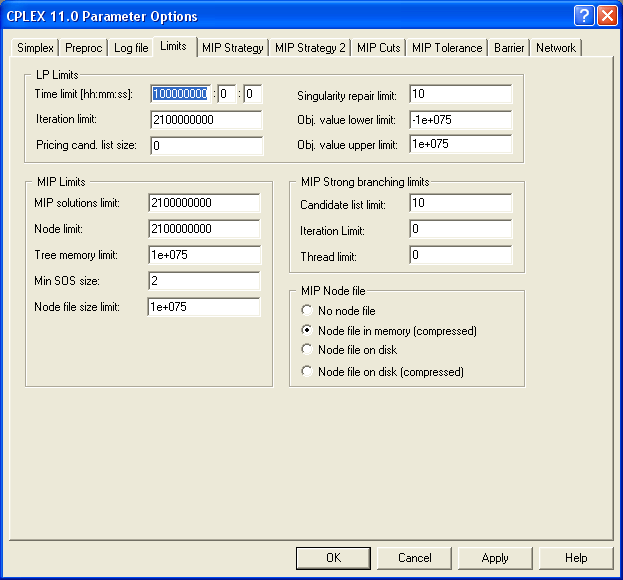
Figure 4.45: The CPLEX Limit Options Dialog Box
You can change the Limit options for CPLEX by choosing CPLEX parameters from the Options menu and then pressing the Limits tab. This will display the dialog box shown below:

Figure 4.45: The CPLEX Limit Options Dialog Box
| Option Name | MPL Name | Solver Param | ParamNr | Type | Default | Min | Max |
|---|---|---|---|---|---|---|---|
| Time Limit: | SolutionTimeLimit | TiLim | 1039 | real | 1e75 | 0 | MAXREAL |
| Iteration Limit | IterationLimit | ItLim | 1020 | int | MAXINT | 0 | MAXINT |
| Pricing Candidate List Size | CandidateListSize | PriceLim | 1010 | int | 0 | 0 | MAXINT |
| Singularity Limit | SingularityLimit | SingLim | 1037 | int | 10 | 0 | MAXINT |
| Object Value Lower Limit | ObjectLowerLimit | ObjLLim | 1025 | real | -1e75 | -MAXREAL | MAXREAL |
| Object Value Upper Limit | ObjectUpperLimit | ObjULim | 1026 | real | 1e75 | -MAXREAL | MAXREAL |
| MIP Solutions limit | MipSolutionLimit | IntSolLim | 2015 | int | MAXINT | 0 | MAXINT |
| Node limit | MipNodeLimit | NodeLim | 2017 | int | MAXINT | 0 | MAXINT |
| Tree Memory Limit | MipTreeMemoryLimit | TreLim | 2027 | real | 1e75 | 1 | MAXREAL |
| Min SOS size | MinSosSizeLimit | SOSMinSz | 2024 | int | 2 | 0 | MAXINT |
| Node File Size Limit | MipNodeFileSizeLimit | NodeFileLim | 2030 | real | 1e75 | 1 | MAXREAL |
| Strong Branching Cand Limit | MipStrongCandListLimit | StrongCandLim | 2045 | int | 10 | 1 | MAXINT |
| Strong Branching Iter Limit | MipStrongIterLimit | StrongItLim | 2046 | int | 0 | 0 | MAXREAL |
| Strong Branching Thread Limit | MipStrongThreadsLimit | StrongThreadLim | 2047 | int | 0 | 0 | MAXREAL |
| MIP Node File | MipNodeStoreFileInd | NodeFileInd | 2016 | list | 0 | 0 | 3 |
The Time limit option used to set maximum time (in hours:min:sec) for computations before termination. The time limit applies to primal simplex, dual simplex, barrier, and mixed integer optimizations, as well as infeasibility finder computations.
The Iteration limit sets the maximum number of iterations before the algorithm terminates, without reaching optimality. Be sure to enter only an integer value. The default value is 2100000000.
Contains the maximum number of variables kept in the pricing candidate list. If the value is zero the number is determined automatically at run-time.
The Singularity limit value restricts the number of times CPLEX will attempt to repair the basis when singularities are encountered. Once the limit is exceeded, CPLEX replaces the current basis with the best factorizable basis that has been found. At this point the user can examine and modify the problem or increase the singular limit to force CPLEX to work harder at eliminating singularities. The default value is 10.
Setting a lower objective function limit will cause CPLEX to halt the optimization process once the minimum objective function value limit has been exceeded. This limit applies only during Phase II of the optimization.
Setting a upper objective function limit will cause CPLEX to halt the optimization process once the maximum objective function value limit has been exceeded. This limit applies only during Phase II of the optimization.
The MIP solutions limit value limits the mixed integer optimization to finding only this number of mixed integer solutions before stopping. The default value is 2100000000.
The Node limit value sets the maximum number of nodes solved before the algorithm terminates, without reaching optimality. The default value is 2100000000.
The Tree memory limit value sets an upper limit on the amount of memory (in megabytes) that the branch-and-bound tree can consume. CPLEX will terminate optimization when the amount of memory required to store branch-and-bound information exceeds the tree memory parameter setting.
The Min SOS size parameter is used to set the minimum size for sets found during the scan for SOS Type 3 sets. The SOS algorithm may not be worthwhile on smaller size sets. The default value is 2.
The Node File Size Limit option limits the size of the node file.
Controls the length of the candidate list when using the "strong branching" variable selection setting.
Controls the number of simplex iterations performed on each variable in the candidate list when using the "strong branching" variable selection setting. The default setting 0 chooses the iteration limit automatically.
Controls the number of parallel threads used to perform strong branching. This parameter does nothing if the MIP thread limit is greater than 1.
The MIP Node File is used when the tree memory limit is reached. If no node file is selected the optimization is terminated when the tree memory limit is reached. Otherwise, a group of nodes is removed from the in-memory set, and transferred to a node file. This group of nodes is returned to the in-memory set as needed.
Node files are used most efficiently when the amount of tree memory is reasonably large, so that the node files do not have to be formed too frequently. The compression options require a small amount of extra time due to the extra processing but since they result in smaller node files the overall systems is smaller and the system throughput may increase.
| No Node File (0) | No node file |
| Node File in Memory (Compressed) (1) | Node file in memory and compressed |
| Node File on Disk (2) | Node file on disk |
| Node File on Disk (Compressed) (3) | Node file on disk and compressed |